Dream Catchers in the Maya World
by Mari Pinktowski
Editor’s Note: This article first appeared in Sac-Be.com in January of 2014.
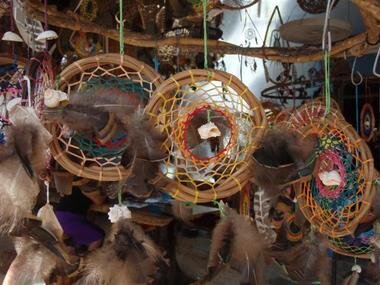
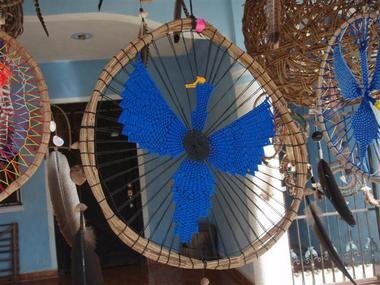
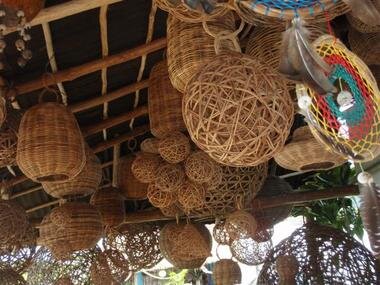
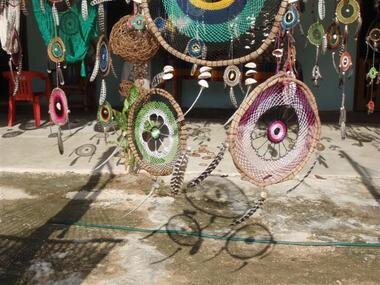
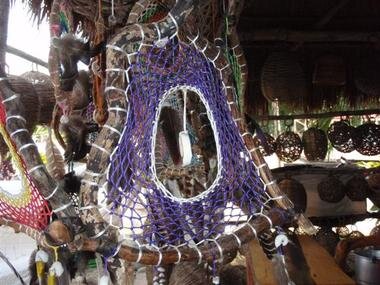
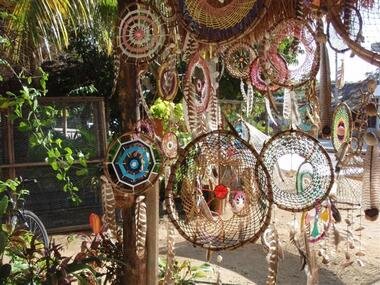
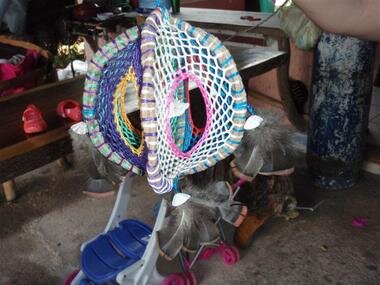
Six months ago as I traveled along the Cobá Road, I noticed that many tiny shops were now selling Dream Catchers. As time went by, I observed that the presence of Dream Catchers was expanding and they were taking on a very creative aspect that was new to me: different shapes, different images, different sizes, colors and combinations thereof.
I decided to research this form of art on the Internet and by talking to local artisans to see if the well-known stories related to the Dream Catcher were part of traditional Maya culture.
I learned that the first Dream Catchers came from the Ojibwa or Chippewa Nations in the northern United States. Many Native Americans believe that the night air is filled with dreams, both good and bad. The legend goes something like this: As the Ojibwa Nation spread to the corners of North America, it became impossible for The Spider Woman, Asibikaashi, to protect all the children from bad dreams that creep into their minds at night. Mothers and grandmothers wanted to save their children from worry and fear, so they began to weave magical webs, later known as Dream Catchers, which would filter out all bad dreams and only allow good thoughts to enter their heads. The purpose of these Dream Catchers (atrapa suenos) was to catch bad dreams in the net that would disappear at daylight. Good dreams would pass through the web and slide down the feathers to the sleepers.
The first Dream Catchers were sometimes shaped like snowshoes and the process of creating the web was similar to making snowshoes. These creations were hung over the bed to protect sleeping people, usually children, from nightmares. As I read on about the significance of the process of making the Dream Catchers and the materials used, I wondered if the Maya artisans had similar ideas or if they were just copying a beautiful weaving.
The Ojibwa hoop was fashioned from willow branches and the net was woven in sinew from animals or cordage from plants. The hoop shape, which was the most typical, was a symbol of identification with North American or First Nation cultures. The circle also represents how the sun and moon travel across the sky. The weavings were then decorated with sacred items like feathers and beads. I was interested to read that the feathers signified breadth, or the air that is essential for life. If owl feathers were used, it signified wisdom.
Before I left to visit my family in Colorado in September, I traveled along the Cobá Road buying a few Dream Catchers at different locations each week to give as gifts to my friends and family. I noticed that each one, although different in size and color, seemed to have about the same number of connections to the hoop that was configured from a local vine that grew in the jungles surrounding this part of Quintana Roo. Months later, I observed the creativity expanding as the Dream Catchers were taking on a more refined and individual look. More complicated designs and shapes were popping up in some locations along the corridor. I needed to know more, so first I went back to the Internet.
My research and observations showed that as time went on there was a greater and greater difference in the design and weave done by the North American Nations vs. the local Maya neighbors. The Ojibwa consciously chose the number of connections they would use on the hoop based on the meaning they were trying to convey. Those with five connections represented a star; six points, an eagle; seven points, the seven prophecies of the grandfathers; eight connections represented the number of legs on a spider; and 13 points were representative of the 13 phases of the moon. The Maya, on the other hand, used many equally spaced connections based on the size and shape of the frame. I suspected this was for strength and balance and did not have a spiritual significance, but I needed to find out.
I decided on the day of my next intercambio (Spanish/English) meeting with Trudy, a lady living in the next pueblo, that we would take a field trip to see what we could learn from our Maya neighbors.
When Trudy arrived, I grabbed my notebook, pen and camera, hopped in her car and headed north under a fine mist that hung over our heads. I let Trudy know, as her Spanish is excellent and her ear well trained, that I needed her help with the interviews of the Maya artisans. She was up for the challenge, so we drove out of the gates at La Selva Mariposa and toward the Cobá Road. We visited four different people, three ladies and a young man.
We stopped first to visit Amelia, just after the second tope on the right in Macario Gomez, next to Los Piratas restaurant. From Amelia, I learned that an 11-year-old boy started the interest in this craft by selling them door to door in the next pueblo, Francisco Hu May, where her sister lives. Her sister, a curious and creative young woman, fell in love with the concept and began to experiment using local materials at hand. Once the skill was perfected, she taught Amelia and her daughter Sulmi to make the smaller version which soon expanded to making more complicated and varied designs. Amelia and her sister both set up shops on their front porches in their own pueblo and sold the Dream Catchers. Since the space was available, Amelia added her father's woven baskets of all shapes and sizes, some vine lamp shades and smaller decorative items and, last of all, some beautiful handcrafted furniture that her husband, Jose, makes. The children, when not in school, play quietly nearby as Amelia weaves her magic.
After purchasing a few Dream Catchers, we drove on to the next pueblo, Francisco Hu May, to continue our investigation. We pulled into the first shop and realized it had to be Amelia's sister, so we ventured on for a different story.
Our next stop, at a tidy shop with very interesting Dream Catchers swaying in the breeze out front, drew us in.
We stepped over a battalion of ants crossing the parking area and walked toward the front of the house. Maria Guadalupe welcomed us in, and her husband came out to greet us as well. I recognized him as Louis, the friendly caretaker at the Honey co-op. He told us that they watched the spider make a web, and then tried to copy this design using twine attached to a hoop made from vines. Maria Guadalupe told us that she and her daughter, Maria Magdalena, make all of the Dream Catchers they sell. Her designs are inspired from nature, especially the local flowers. She showed us a huipil, a traditional Maya dress, she had embroidered with flowers by hand and said she transferred, in her mind, the image she had sewn on the dress to her weaving.
On down the road, we stopped at another small shop and talked to a young man in Manuel Antonio, the third village along the Tulum to Cobá Road, who was weaving in the back room. He said he learned the craft from an older Maya relative who learned from a visitor from North America. His work was much less refined than our last stops, as he was just beginning to learn the technique. The shop owner was aware of the significance of the Dream Catcher in Native American culture.
My attention shifted to the fact that some of the Dream Catchers sold in this village at the shop, Itzamna, were of a different style from the Lakota, another Native American tribe in the western United States, which I had seen on the Internet. With these few Dream Catchers, the hoop is wrapped first in twine or ribbon and then fewer connections are made to the sides, ending with a small hole in the center. Three tiny feathers hang from the bottom of the hoop. Interestingly enough, the Lakota believe nightmares pass through the holes in the weaving/netting and out of the window. Good dreams are trapped in the web and then slide down the feathers to the sleeping person.
We wanted to stop for one more interview and chose the large orange building next to the park in Francisco Hu May, because they have a variety of artisans and crafts. Sandra, a young mother swinging in a hammock chair with her toddler, was eager to chat with Trudy and me. She learned the craft from her mama, who discovered that tourists loved these inexpensive and easy-to-pack gifts. She and her sister began to create the Dream Catchers to sell in the little market space where she and her child spent the day.
All of the local Dream Catchers, no matter the size or shape, were adorned with similar items from nature. Amelia and Maria Guadalupe let us know that they bought the turkey, chicken and wild bird feathers, and shells and beads from people passing by, or gathered them up at family homes in Chemax, a larger pueblo where many of the locals from these villages originated from. Sandra said her father and brothers took the feathers from wild turkeys and birds they hunted and found shells and seeds on beaches and in the jungles nearby.
All of the artisans interviewed used the same nylon colored twine that is used to make hammocks. Amelia told us it was called Two-Elephants and she and others usually bought this at the public market in Valladolid.
The forms or frames used by all artists are fashioned from a local vine when it is soft and green. They are dried before being used as the base of the weaving. It was interesting to see a long row of them drying at the side of Maria Guadalupe's shop.
Because many of Amelia's Dream Catchers had elaborate designs, I asked her and the others about the amount of time it took to create one, and how the prices were decided upon. Not surprisingly, the amount of time depended on the size and complexity of the design. From one to four hours was the response. The latest creation of tiny earrings could be the most difficult project yet. The prices at each shop were identical and started at 20 pesos ($1.50 US) and went upwards to 250 pesos or a little more than $20 US. There is usually room for bargaining.
Learning a new craft is fun for me, and each artisan shared the same feeling. All of the locals interviewed were somewhat familiar with the origin of the Dream Catcher legend. Because this is not a tradition of the Maya people, it had little significance to the weaver. They simply enjoy creating and each design is a unique, one-of-a-kind collectible. There is no pre-design or drawing; instead each art piece develops organically with the mind and hands of the artists working together. What could be a better keepsake from your travels along the Tulum to Cobá corridor than a unique Dream Catcher?
